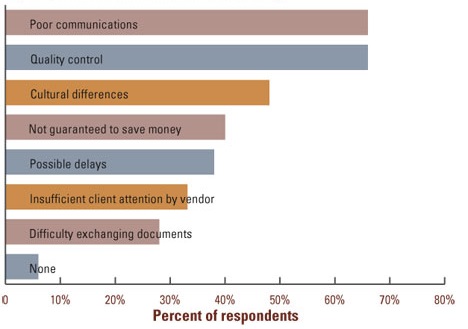5 Real Struggles and Disadvantages of Offshore Outsourcing
- Kevin Oskow
- March 24, 2020
- 7 Minute Read

Quick Summary: This blog discusses why offshore outsourcing is failing for some businesses and what are the major struggles and disadvantages of offshore outsourcing. First, there are some statistics that show a drop in total IT outsourcing revenue from 2019 to 2020 and then there are some real struggles businesses have witnessed with offshore outsourcing. But we do not conclude here and we give the most perfect solution to make offshore outsourcing productive and so away with the listed struggles through dedicated teams.
It’s frustrating, we know.
Outsourcing promised the world to global companies, only to reveal that there were pitfalls hiding under what seemed to be a smooth road surface.
Here are some routinely cited challenges CxO’s face with offshore outsourcing key departmental functions.
Before that, Some Numbers:
- The total contract value of ITO across the globe decreased from US$76.6 billion in 2019 to US$66.5 billion in 2020, informs Statista.
- A 2019 article mentions that many large multinational companies (MNCs) are moving away from outsourcing to global in-house centers (GICs).
- The British outsourcing market crashed by 25% in 2018, indicating the burgeoning distrust of the model across geographies.
Why’s that a Bad News?
Because companies that have had their hands burnt while trying outsourcing models are finding it hard to nail down the true cause of failure:
- Is it the offshore outsourcing model that’s failed?
- Or, is it the lack of control inherent in the traditional offshoring model, that caused the failure?

By saying NO to offshore outsourcing, they’re failing to pinpoint the cause of failure, and as a consequence, foregoing the tremendous benefits of offshore outsourcing.
We could fill out pages if we were to go into the reasons that make offshoring lucrative for companies.
There are some inevitable benefits that make the disadvantages of offshoring fade away:
- Increased competition in a globalized market has big businesses searching for offshoring their IT needs to keep costs low.
- For many industries, offshoring is an avenue of competitive edge.
- The talent shortage is also a factor fueling the ITO market.
These advantages of offshore outsourcing are too good to ignore, which means global leaders need to address the challenges posed by the traditional offshoring model and overcome them.
Here, we present the real challenges a majority of companies face with managing offshore teams and their offshore company partners. We also provide a solution, of course!
Top 5 Disadvantages of Offshore Outsourcing and their Solutions
1. Limited Control over Shared Resources
Sharing resources, including proprietary business knowledge, is necessary for any outsourced project.
Offshore IT outsourcing is not beyond that. But the headache level is different when dealing with the advantages and disadvantages of offshoring.
How do CxOs deal with this, traditionally?
You will try to develop a watertight contract, of course, believing that to be an adequate guarantee against the unauthorized use of shared resources.
However, with your offshore team working at the other end of the world, your control of the shared offshore resources will remain constrained.
The 2013 Trust-wave Global Security Report (2013) studied 450 data breach investigations and found that 63% were linked to a third-party component of IT administration.
It will be difficult, if not impossible, to detect data leakage. There may be sufficient damage by the time you detect it. In the case of shared resources involving data protected by privacy regulations in your country, the challenge increases manifold.
By design or by mistake, your offshore team causes a data breach. Can you even begin to think about how drastic the impact could be for your company?
Solution
You need to sign a White Label contract with strict NDA terms and have your documentation complete. With this, the best solution for managing security while offshoring is by hiring a dedicated offshore team, so you know your exact team structure and can identify the resources working on your project. This gives you the same level of transparency as your inhouse team.
2. Frustrations with Managing Offshore Teams
One of the major offshore company benefits is supposed to be the reduction in overhead costs. But what about the exasperation overhead?
Here are some examples:
- Chances are that your offshore company follows business and management processes very different from your own.
- Time zone differences and linguistic and cultural barriers make matters worse.
- Expect friction around documentation standards, nomenclature, level of detail, etc.
Here’s an example.
- Think of something as simple as an invoice.
- Your company needs the invoice from your offshore team in a particular format.
- Your offshore team insists that they do their invoices in a different format and they see no reason to change that.
- They may also say that any change in their invoicing format will land them in legal trouble.
For all you know, you may need several email exchanges with one or two Skype calls thrown in to sort out just this simple thing. Can’t you imagine how exasperating that can be?

You thought one of the best advantages of offshore outsourcing would be to offload most of your responsibilities, did you?
Solution
Yes outsourcing your project requirements to offshore teams help you cut down the operational expenses and sometimes if you outsource to a country like India you can get good IT expertise at a lower cost as compared to your in-house team. But, management can be a hassle and it is a good idea to hire dedicated experts offshore or a team of dedicated experts, who would be managed according to your project priorities and can work according to your time zone.
You would be amazed to know that 80% of the Fortune 500 companies have their dedicated offshore development teams for cutting down on their operational costs.
3. Limited Control over Offshore Team Structure and Functions
With an offshore company partner, you have no control over the offshore team structure, or over how different functions are allocated to different team members. Staff retention is also an issue. The remote team manager will have the full right to shift around team members.
How’s this a problem?
- You may suddenly discover that one team member you could best communicate with has been allocated to a different project.
- Worse still, you may receive an email informing you that your offshore team leader is no longer working for that company.
- With no idea about the capabilities of this new person, you’ll naturally worry about what impact this change might imply for your project.
- Combine with that the need for you to establish a rapport with a new person just when you thought you and your offshore team leader have started to speak in the same language.
Doesn’t seem to be a very inviting situation, does it?
Solution
Decide your team structure and team members yourself by choosing the dedicated team model. You can choose the number of members, the expertise level and can transparently build your own team offshore. As you choose the dedicated team model, the outsourcing vendor cannot change your team size or structure and the resources allocated will dedicated work on your project. You can manage them as easily as your in-house team and get great expertise at almost half the cost of your in-house resource.
Does this sound a fair deal now?
4. Lack of Transparency in Pricing, Resulting in Overcharging

Management processes of your offshore partners could be rigid enough to disallow any such mid-project scalability.
In fact, this is a major value-leakage for traditional outsourcing contracts, with key issues such as:
- Keeping teams top-heavy to inflate billables by compromising agility
- Low potential for upskilling people to enable internal promotions
Your offshore team leader may argue that the hike that seems unreasonable to you is something they cannot do without if they have to get extra human resources for your project.
With little control over the team structure and functions, little knowledge of the employment rules in that country, you will be in a difficult position to negotiate too much. And this can be a hidden disadvantage of offshoring.
Solution
The fixed-price model or the traditional project-based model fades the scope for flexibility or scalability in project requirements once the project cycle begins. And therefore brands have started utilizing the ‘dedicated team model’ where they have the power to change the project priorities, alter its scope and manage the offshore team and resources according to their business priorities.
5. Lack of Control over Day-to-Day Work
When working with an offshore company, you will have no access to the daily activities of the remote team. You may feel that your project progress is slower than you had expected. You may certainly share your concern and ask for an explanation.
But you’ll be compelled to accept whatever explanation your offshore company provides. With no visibility of day-to-day work, you will be in no position to figure out what exactly is wrong.
And that’s like being in a room with a spider; you know it’s there, you just can’t see it.
Combine with these the other typical disadvantages of offshore outsourcing like an urgent communication being delayed because of time zone differences. Or the cultural difference that makes you feel your offshore team leader beats about the bush far too much while they may think you are downright rude.
There are certain apparent disadvantages of offshoring. However, developing a GIC is not feasible for every company. What, then, is the solution?
Solution
Sometimes the nature of your project requires you to take a look at the day-to-day work progress or there may be issues like delayed timelines or a deflection from the actual project scope. And therefore a better choice would be to hire a dedicated team where you could not only transparently look but manage the day to day activities of your offshore team. This could help you earn the expected productivity from your offshore teams and keep you informed about the progress in your projects.
We Recommend The Dedicated Team Model
No, we are not blind to the advantages of offshoring ITO. We are not asking you to give up on offshore ITO altogether. We are not proposing that you do everything in house, which will undoubtedly increase your overhead costs considerably, among other things.
We are proposing a dedicated team model, which combines the top benefits of offshore outsourcing with the top advantages of having an in-house team. And, it eliminates the disadvantages of both! The dedicated team model offers the ideal cost-effective solution for your ITO needs.

Thank you for submitting the details!
We will keep your information safe. Feel free to contact us with any questions at hello@uplers.com
Please check your email for next steps shared by Robert.


















